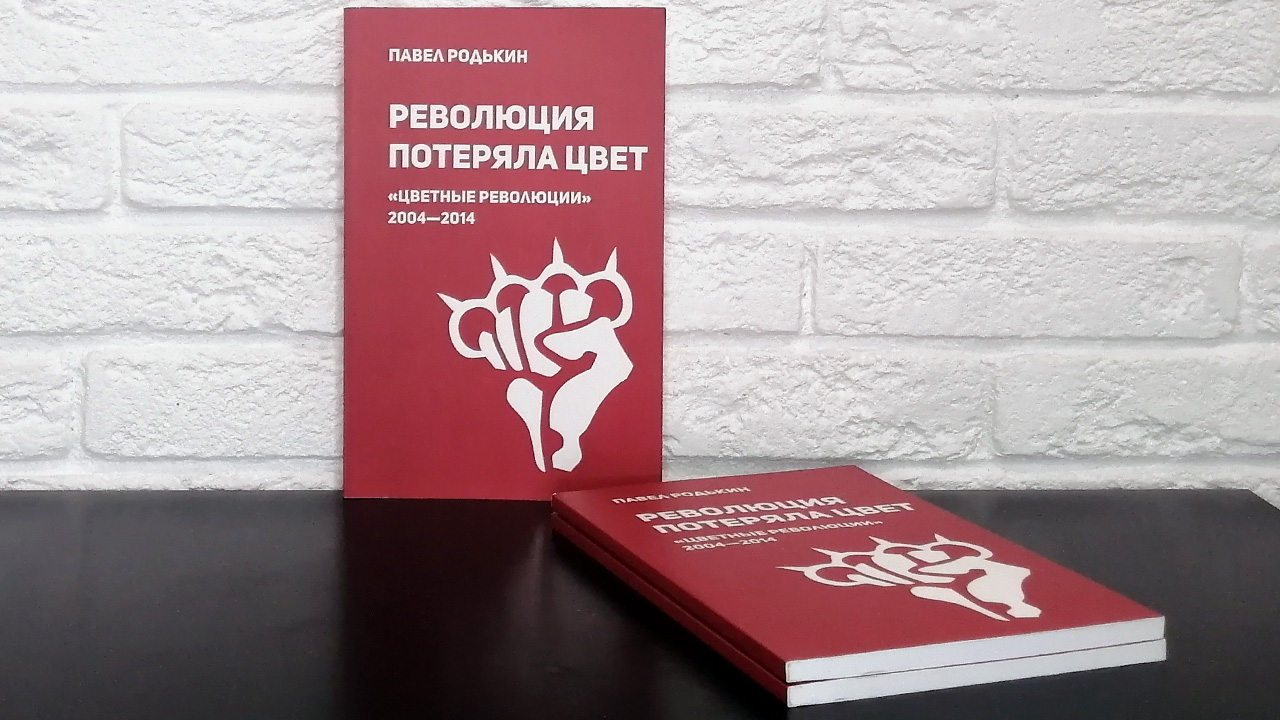

Rodkin, P. (2015). The Revolution has Lost Color. The "Color Revolutions" 2004—2014: Humanities and Communications Phenomenon of New Type of War. Moscow: Sovpadenie. 120 p. (In Russ.). [Rod'kin, P. (2015). Revolyuciya poteryala cvet. "Cvetnye revolyucii" 2004—2014: gumanitarnyj i kommunikacionnyj fenomen vojny novogo tipa. Moskva: Sovpadenie.].
The book is devoted to the study of Humanities and communication technologies "color revolutions" that occurred in the world from 2004 to 2014 and reflects the changing nature of the modern "color revolutions" that allows us to reinterpret this phenomenon in the context of global socio-political processes.
Language: Russian
Design: Pavel Rodkin
Paperback: 120 pages
Size: 130x200 mm.
ISBN 9785903060474
© Rodkin, P., 2015
© Publishing house "Sovpadenie", 2015
Introduction
"Velvet" revolution becomes "colored"
The model "Orange Revolution": a view from 2004
"Color revolutions" are no longer non-violent
"Euromaidan" as a tipping point
Ukrainian crisis and problems of post-Soviet identity
What revolutions should Central Asia prepare for?
"Color revolutions" in the post-Soviet space
Asia resists "color revolutions"
Lessons from Gezi protests: environmental protest grows into a "color revolution"
Russia: an attempt at the "White Ribbons Revolution" of 2011—2012
Instead of a conclusion
Supplement: chronology of "color revolutions" in the world 2000—2014

If in Nikonov the reader finds the author's reflections on possible ways of development of events in Ukraine, then the book of Associate Professor of the Higher School of Economics Pavel Rodkin "The revolution has lost its color. Color revolutions 2004-2014" again draws us to the theme of "Euromaidan". These events, inevitably compared with the "orange revolution" of 2004, according to the author, were not a deviation from the peace scenario, but the technical implementation of a coup d'etat plan. According to the data presented, over the period from 2000 to 2014, more than 20 "color revolutions" and attempts to implement them took place in the world.
P. Rodkin, claims that "since 2004, the "color revolutions" have undergone a significant transformation. They became violent, the most archaic archetypes, symbols and forms of pressure on the political regime came to the fore. Globally, "color revolutions" have turned into counterrevolutions. The media image no longer requires the resource-intensive technology of non-violent communication protest".
Olga Ivlieva. International Affairs magazine, 12.02.2016.
An original study by Pavel Rodkin, PhD in art history and expert in branding and visual communications, analyzes the humanitarian and communication technologies of the "color revolutions" that took place in the world from 2004 to 2014. Having stated that symbolically and ideologically they demythologized power, the author demythologized the "color revolutions" themselves, which allows us to rethink their phenomenon in the context of global socio-political processes.
In 2004, one of the most important elements of the Orange Revolution in Ukraine was the corporate identity, opposed to the official symbolic systems of state power. By taking possession of a mass of people, he created an emotionally powerful protest identity and motivation for confrontation, and orange became a communicative interface with which it was possible to rally protesters, manipulate them, and present a vivid "picture" for the rest of the world. The author explains: "The corporate identity of the Orange Revolution is, in fact, a standard practice, developed and developed since the beginning of the 20th century in the corporate environment. This refined system did not go beyond corporate identity and marketing strategies. The use of corporate identity in "big politics" as a basic discourse was not considered seriously by the authorities".
When this became a fact, the Ukrainian authorities were at a loss. Rodkin writes: "The traditional model found itself in a state of communication shock, and even the presence of a media resource could not help it in opposing the corporate identity of the "Orange Revolution"".
Political rhetoric was instantly destabilized by a kind of visual revolution, unable to oppose it with anything as clear and visible. At some point, the corporate identity of the Orange Revolution became psychologically associated with official Ukraine more than its yellow-blue flag and other state symbols. Rodkin also notes that for Russia "the phenomenon of "color revolutions" began and entered the political and public agenda since the "orange revolution" in Ukraine in 2004. It was the "orange revolution" that shaped the image of the "color revolution" for Russian society and for a long time determined the attitude towards this phenomenon".
However, after these dramatic events of 2004, the "color revolutions" began to change rapidly, rolling back to traditional forms of confrontation. The author illustrates this evolution by analyzing the events that took place in Kyrgyzstan, Belarus, Armenia, Moldova, Hong Kong, etc. The comparison of the "Orange Revolution" and "Euromaidan" is especially striking, during which literally all the methodological recipes for non-violent protests were violated. During the Euromaidan, the ban on violence was dropped, and the main characters were members of the paramilitary groups of Ukrainian nationalists. At the same time, the unity that took place in 2004 was lacking within the anti-government forces.
Literary newspaper. 2015, 11 (6501).